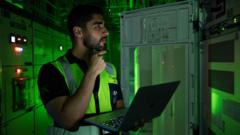Could a Tsunami from Japan's 8.8 Magnitude Quake Threaten Hawaii and the US Coast?

Understanding the Impact of Tsunamis Following the Recent Earthquake in Russia and Japan
This morning, an 8.7 magnitude earthquake rattled the regions of Russia and Japan, triggering tsunamis that struck the Kuril Islands and the northern island of Hokkaido. As warnings spread across the globe, coastal areas in the United States, particularly Hawaii and parts of the West Coast, are on high alert. The seismic event has raised concerns about safety, preparedness, and the potential for widespread destruction in affected areas. In this article, we will explore the implications of such natural disasters, the science behind tsunamis, and the importance of preparedness in mitigating risk.
The Science Behind Tsunamis
Tsunamis are massive ocean waves typically caused by underwater seismic activity, such as earthquakes, volcanic eruptions, or landslides. The energy released during an earthquake displaces water, generating waves that travel across the ocean at high speeds. When these waves approach shallow coastal areas, they slow down and increase in height, leading to the potential for devastating impacts upon landfall.
Recent Tsunami Events: A Closer Look
The recent earthquake off the coast of Russia and Japan has led to significant tsunami activity in the region. Reports indicate that waves have struck the Kuril Islands and Hokkaido, prompting warnings for additional regions in Japan and extending to the United States, including the west coast and Hawaii. Evacuations have been initiated in coastal areas to ensure public safety.
In Alaska, reports of wave heights reaching up to 30 centimeters above tidal levels have been recorded. While these waves have not led to significant damage, they underscore the necessity of preparedness in the face of such natural phenomena.
Precautionary Measures and Emergency Response
In the aftermath of a tsunami-triggering earthquake, immediate action is crucial. Here are key precautionary measures that individuals and communities should consider:
- Evacuation Protocols: Follow local authorities' guidance to evacuate coastal areas promptly.
- Know Your Zone: Familiarize yourself with tsunami evacuation routes and safe locations.
- Stay Informed: Monitor local news and alerts from the National Tsunami Warning Center and other authorities.
- Emergency Kits: Prepare emergency kits with essential supplies, including food, water, medications, and flashlights.
- Community Drills: Participate in community tsunami drills to ensure readiness and awareness.
Global Preparedness for Tsunami Threats
Given the potential for tsunamis to affect numerous countries across the globe, international preparedness is essential. Countries in seismic zones need to invest in early warning systems, public education, and infrastructure designed to withstand tsunami impacts. Collaboration between governments, scientists, and communities can foster a culture of preparedness that saves lives.
Countries like Japan, which has experienced numerous tsunamis due to its location along the Pacific Ring of Fire, have established comprehensive warning systems and public awareness campaigns. These efforts have significantly reduced fatalities from tsunami events. However, other regions, such as parts of the United States, are still developing their response capabilities.
The Role of Technology in Tsunami Monitoring
Advancements in technology play a critical role in tsunami monitoring and response. The integration of satellite imagery, seismic sensors, and ocean buoys allows for real-time data collection and analysis. This technology helps scientists predict tsunami formation and guide timely evacuations, thereby minimizing loss of life and property damage.
Furthermore, mobile applications and social media platforms have become invaluable tools for disseminating information quickly. By providing timely updates and alerts to residents in at-risk areas, these technologies enhance community preparedness and response efforts.
Implications for Coastal Communities
Coastal communities face unique challenges when it comes to tsunami preparedness. High population densities, tourism, and economic reliance on coastal resources often complicate evacuation efforts. Therefore, it is vital for local governments to develop tailored strategies that address these challenges while promoting public awareness and safety.
Some effective strategies include:
- Implementing zoning regulations that limit development in high-risk areas.
- Creating community education programs that raise awareness about tsunami risks.
- Establishing strong communication networks to relay information before, during, and after a tsunami event.
The Psychological Impact of Tsunamis
Beyond physical damage, tsunamis can have profound psychological effects on affected communities. Survivors may experience anxiety, depression, and post-traumatic stress disorder (PTSD) due to the loss of loved ones, homes, and livelihoods. Mental health support should be an integral part of disaster recovery efforts to help individuals cope with trauma and rebuild their lives.
Frequently Asked Questions
What should I do if I feel an earthquake?
If you feel an earthquake, it is crucial to drop, cover, and hold on. Once the shaking stops, quickly assess your surroundings for safety and listen for tsunami warnings.
How can I prepare my family for a tsunami?
Prepare your family by creating an emergency plan that includes evacuation routes, a designated meeting place, and an emergency kit. Regularly practice your plan to ensure everyone is familiar with the procedures.
Are tsunamis only caused by earthquakes?
No, while earthquakes are the most common cause of tsunamis, they can also be triggered by volcanic eruptions, landslides, and even meteorite impacts.
How can I stay informed about tsunami warnings?
Stay informed by signing up for local alerts, following emergency management organizations on social media, and utilizing mobile apps dedicated to disaster alerts.
As we reflect on the recent tsunami events triggered by the earthquake in Russia and Japan, it's essential to recognize the importance of preparedness and community resilience. Every coastal community should prioritize safety measures and education to mitigate the risks associated with tsunamis. How prepared is your community for a tsunami? #TsunamiAwareness #DisasterPreparedness #NaturalDisasters
Published: 2025-07-30 05:26:53 | Category: News



